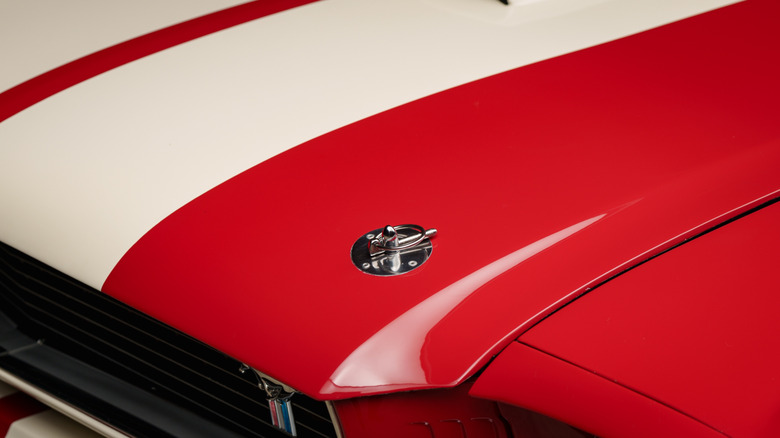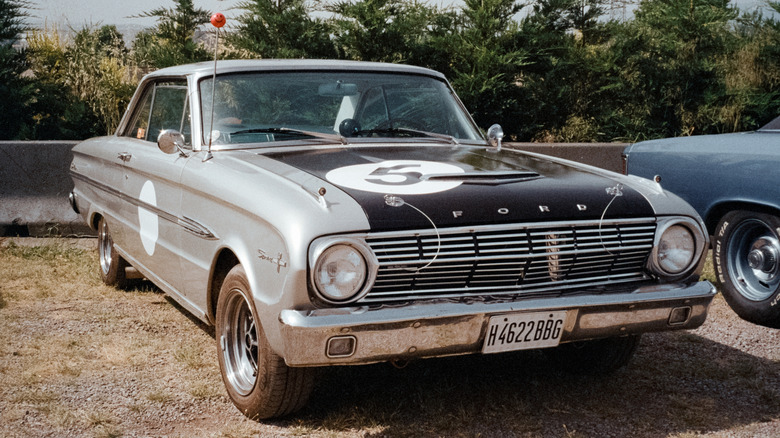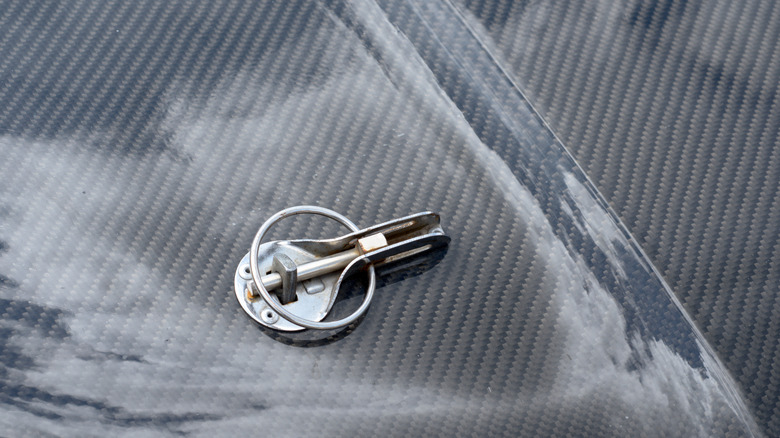What To Know Before Installing A Hood Pin On Your Muscle Car
Some muscle cars have hood pins, but they're not there just because they look snazzy. Back in the muscle car heyday of the late 1960s and earyly '70s, many of these cars could generate enough lift at the hood's front edge to force open or break the stock latch, causing the hood to snap open and smash against the windshield at speed. Plenty of movies and TV shows from the era show hoods flying open and being torn from their hinges, but this seems to be a chase-scene trope and not a common real-world occurrence. Hood pins were first used in auto racing in the 1960s to supplement the stock latches and gradually faded from factory offerings as horsepower numbers plummeted in the early and mid '70s. There still are plenty of aftermarket solutions though, like the Kipa universal stainless chrome hood pin kit available from Amazon for $15.99.
Good hardware, tools, and a clean safe place to work are essential, and you'll want to adhere to the old maxim "measure twice and cut once" to avoid putting any extraneous holes in your hood. Prepare to protect all the drilled holes and cut edges against corrosion and reinforce fiberglass hoods with a backing plate in order to prevent any damage from flexion. If you plan on racing the car, make sure that you're adhering to the rules set forth by the appropriate sanctioning body. For example, the NHRA requires hood pins that supplement the factory latch, not replace it. Hood pins are permanent and can also affect a car's resale value, so stick to period correct solutions that match well with the rest of the car.
How to install hood pins on a muscle car
The most common hood pin format is torsion pins paired with matching cotter pins or similar clips, but you can find newer ones with push-button or other quick-release mechanisms. Whichever type you choose, the most important step of the installation is choosing a spot to mount the vertical pins. The radiator core support, frame, and motor mount brackets can provide helpful mounting points, just make sure you pick an accessible spot away from any moving engine parts.
Welding the bolt directly onto the mounting points is a good choice, and some hood pins can be threaded or bolted into the holes for the hood stops. Either way, make sure your measurements are precise and all the hardware is properly aligned and distributed. You'll also have to account for the pin's mounting angle and the thickness of the hood. Once the bolts are mounted, put a drop of thread locker or marking paint on the tip of each one and slowly lower the hood until the paint has transferred and you can see exactly where to drill the holes. Avoid these common drilling mistakes, and replace any damaged or rusted fasteners.
Make sure you have the right drill bit or cutting tools for your hood; fiberglass, carbon fiber, aluminum, and steel each have different structural properties. The hardware you use and how tight you torque it will also depend on the hood material, and every choice will be a compromise between convenience, economy, and durability. Once everything is mounted, you might need to adjust the hood hinges to line it all up and make sure the hood closes securely. Work slowly and deliberately and adjust as you go, since poorly fitted hood pins aren't good for much more than nonexistent ones.
Are hood pins difficult to install?
While it's not exactly one of the easiest DIY auto maintenance tasks, installing hood pins requires no specialized tools, knowledge, or experience. The process is fairly simple though, and most people familiar with basic shop work should be able to manage it without too much trouble. It helps to have a second person to help you lift and place the hood and a couple sawhorses to set it aside for drilling.
The real challenges with this installation come with finding mounts for the pins, lining up the pilot holes in the hood, and fitting the final installation so nothing is rattling around too badly. Sloppy work here can lead to noise, vibration, and even a failure of the hood pins. If you're not confident installing hood pins on your own, there's no shame in taking this safety-related task to a qualified body shop or experienced mechanic.


